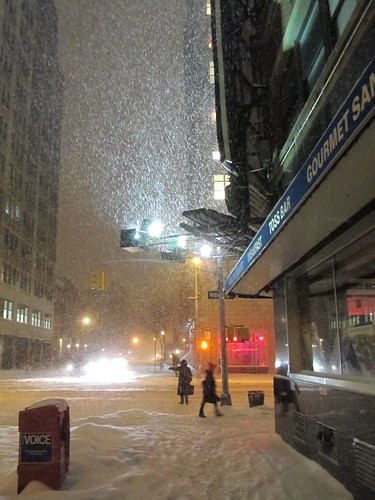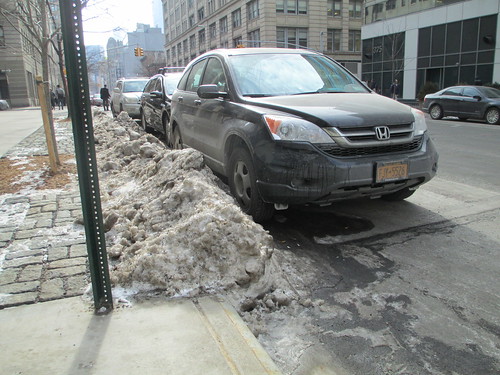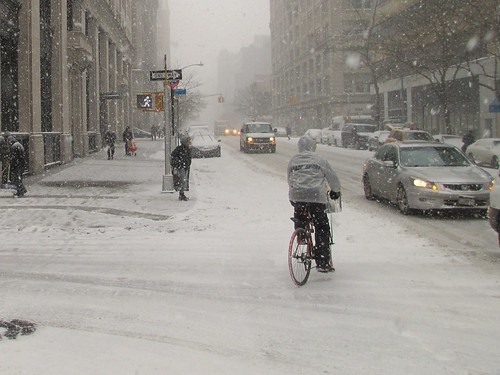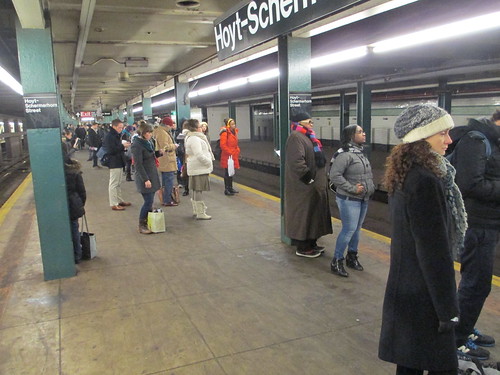It’s not the kind of issue that normally preoccupies me while
I’m cycling. But, glancing down at my bike computer, I could see my pace had
dropped. Where shortly before the average speed figure had been showing
16.5mph, it was now showing 15.1. The dip gave me fresh determination. “Speed
up!” I ordered myself. “Reach the top of the hill without dipping below 15!” A
few seconds later, I crested the hill in Prospect
Park , near my house in Brooklyn , with my computer still showing a 15mph average
speed. Slipping my chain onto the biggest chainring, I sped up off down the
hill towards Grand
Army Plaza
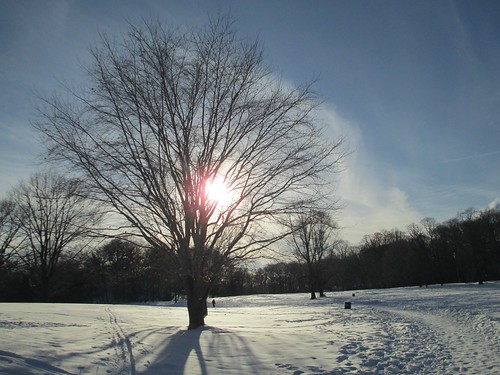 |
| Prospect Park in the snow: however badly I ride round it, it's a breathtaking backdrop for my humiliation |
This wasn’t my normal kind of bike riding, however. I’d seen
earlier in the day the forecast for yet more snow for New York City – it’s already the city’s
seventh-snowiest winter on record – and I thought my chances of commuting by bike
in the next few days were limited. I consequently decided, although I didn't have anywhere to go, to use a break in the weather to get some exercise. Checking that I had no immediate domestic
responsibilities, I slipped off after church for a very brief bout of cycling
purely for the physical activity.
I’ve found myself, when I’ve been undertaking these rides, involved
in an activity that’s both entirely familiar to me and rather alien. I’m used,
of course, to riding my bicycle (even if this winter has made that hard-going
at times). I’m accustomed, however, to focusing on getting where I’m going in
one piece – which can be demanding in a city full of angry drivers and bad road
surfaces. I’m not used to focusing on the cycling – or its effect on my body –
for its own sake.
I’ve been interested to discover how negative many of the associations in my mind of taking pure exercise are. As my
pulse rises and my breath grows wheezier, I’m back amid the humiliations of a
secondary school playing field. I feel the scorn of the teachers and my fellow,
marginally less inept pupils for my uselessness at playing rugby union. As
steely-faced weekend road warriors pass me, their wheels making the distinctive
rumble of expensive carbon-fibre, I feel fat, lethargic and more than a little
silly.
And, yet, I have to remind myself, it is this alien activity
– rather than my daily transport cycling – that many people regard as the most authentic way to ride a bicycle.
This isn’t to say I’ve never cycled just for the sake of it
before. My love for cycling developed substantially during my years at St Andrews University
That early, carefree exploration culminated in the summer of 1990, when I alternated between
working at clearing out my recently-deceased grandfather’s house and spending days
exploring Scotland. I’d head off in the morning for a ride that took me up the
shore of the Gareloch – a ride made spookier by the area’s hosting the
tightly-secured base for the UK ’s
nuclear missile submarines. I’d head back to Glasgow
via the shores of Loch Lomond . I’d ride,
pushed by the prevailing winds, from Glasgow to Dunfermline in the morning. Then I’d push down hard on
the pedals and hunch down for a long ride back – via the Forth Road Bridge and into the wind - west.
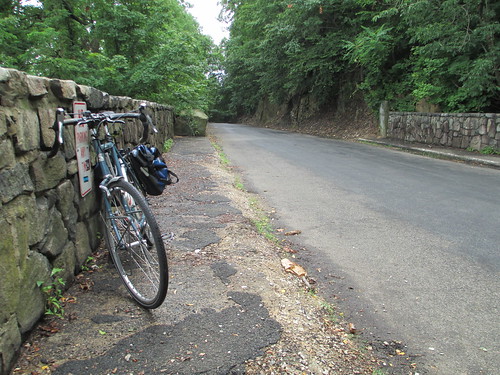 |
| "It's nice out here," remarks my bike during a rare trip outside New York. "Why don't we do this more often?" |
I didn’t find things too complicated back then. I wore no
helmet, carried no supplies, rode a very basic Raleigh bike and worried about pretty much
nothing. Caught in a tropical-style West-of-Scotland summer downpour? Dry
yourself off under the hand dryers in the lavatories at lunchtime. Bit off more
than you could chew with this 100-mile ride? Stop in every other village for a
pint of milk to glug down.
I’ve had occasional bouts of just-for-the-sake-of-it riding
since then, albeit the time constraints and obligations of adult life have
curtailed them. When I lived in London , I’d occasionally
make it to Richmond Park – the vast royal park in south-west London - where rides are enlivened by the possibility of a collision with a big, wandering deer. Last
summer, with the family absent, I took two long rides over New
York City ’s boundaries, over into New Jersey
and up into Westchester .
 |
| Bored with just riding round the park in circles? Why not ride round it on a tall bike, like this guy? |
But there’s something about riding in circles in Prospect Park
– Brooklyn’s smaller equivalent of Central Park ,
non-New Yorkers – that feels far more self-consciously like Exercise - or Training, as it's now been rebranded - than any
long trip to the different scenery out of town. The other riders in Prospect Park
No-one would make that mistake with me. I arrived in Prospect Park
That self-consciousness only rose as I started to ride,
heading down the hill towards Flatbush, and sped along the road between the
lake and the parade grounds at the park’s lower end. It became clear as I
started climbing the hill – the ridge over which British
and American forces fought the battle of Brooklyn
in 1776 – that I was making an effort. I started to breathe hard and wondered why I
always seem to have a cold. I briefly felt myself once again 15 and on a
mud-spattered, rain-soaked cross-country run.
But much of the reward of this exercise is that I’m avoiding
not doing it. In weeks when it’s been hard or impossible to ride, I’ve built up
a deep twitchiness at my lack of activity, the shortage of time spent outside,
a feeling of being trapped when commuting, sedentary, on the subway. Even a
short, fast ride starts to scratch that itch.
And, as I powered up the hill, I remembered that I was no longer entirely
the unfit, unco-ordinated teenager. While my flabby torso isn’t much of an
advert for commuter cycling, it sits atop a pair of legs that have spent years propelling
me to 4,000 miles or more a year of riding first through South London and, now,
daily between Brooklyn and lower Manhattan. Even if some of the weekend
warriors overtake me on a climb, I generally gain the occasional, minor victory,
pumping my legs up the hill past one of them.
I started to feel the pleasure of how a bicycle magnifies one’s
effort. Pumping my legs, I climbed the hill smoothly by my standards, at around a
steady 14mph. Down the hill, my biggest gears propel me to close to the park’s
25mph limit and I felt the childish sense of joy that always comes with giving
oneself over to gravity’s acceleration. I started to feel a deep sense of contentment - the result, I imagine, of the release of endorphins, the exercise-related high that
people keener on exercise for its own sake chase so hard.
I realised after a while that that feeling of contentment wasn't unfamiliar. I recognised how much of the time when I’m riding I’m running late,
pushing myself to reach the next lights before they turn red, powering up the
Manhattan Bridge to avoid being late for a meeting, switching to the big
chainring to get uptown faster, accelerating away from traffic lights to get
out of the way of that badly-driven taxi.
There’s no immediate danger of commuter cycling’s turning me
into a lean, efficient cycling machine like the ones whirling efficiently round
Prospect Park each weekend. But, as I turned out of the park again and prepare
once again to tackle the indifferent conditions of New York City ’s streets, there was no
doubting that I was feeling better.
I appreciate with my higher brain centres the many more and
practical reasons why more and safer cycling would make the city a better
place. But the deep satisfaction that I felt flooding through my body reminded me that, no matter how deep my embarrassment, I retain a childish joy at the
simple act of riding a bicycle. The day it starts to fade will be the day I feel as old as I look.


